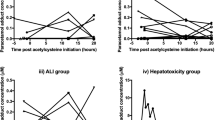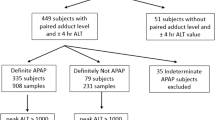Abstract
Introduction
Acetaminophen-cysteine adducts (APAP-CYS) are a serum biomarker of acetaminophen exposure, formed when the oxidative metabolite of acetaminophen binds to cysteine residues of hepatic proteins. APAP-CYS adducts become elevated in cases of acute liver failure following acetaminophen overdose and have been proposed as a diagnostic tool to identify acetaminophen-induced acute liver failure when standard testing is inconclusive.
Case Report
A 26-year-old female with history of unexplained, severe hepatitis presented with a second episode of severe hepatitis including coagulopathy and transaminase levels >10,000 U/L. The patient reported ingesting “only a couple” of acetaminophen tablets several days prior to her presentation. An acetaminophen concentration of 14 mcg/mL at presentation aroused suspicion that acetaminophen might have caused the patient’s liver failure, despite her adamant denial of overdose. APAP-CYS adduct levels measured from serum obtained 4 days after her presentation and in two consecutive serum samples are reported alongside previously reported APAP-CYS levels.
Discussion
The patient’s APAP-CYS adduct levels were consistent with those seen in acute liver injury due to acetaminophen toxicity, even up to 1 week following presentation, and allowed for confirmation of acetaminophen toxicity as the cause of the her hepatitis. Overall, this case demonstrates the real-time application of APAP-CYS adducts as a biomarker to diagnose acetaminophen toxicity in patients with indeterminate acute liver failure.


Similar content being viewed by others
References
Bond GR. Acetaminophen protein adducts: a review. Clin Toxicol (Phila). 2009;47(1):2–7.
James LP et al. Acetaminophen protein adduct formation following low-dose acetaminophen exposure: comparison of immediate-release vs extended-release formulations. Eur J Clin Pharmacol. 2013;69(4):851–7.
Heard KJ et al. Acetaminophen-cysteine adducts during therapeutic dosing and following overdose. BMC Gastroenterol. 2011;11:20.
McGill MR et al. HepaRG cells: a human model to study mechanisms of acetaminophen hepatotoxicity. Hepatology. 2011;53(3):974–82.
Cook SF et al. Quantification of a biomarker of acetaminophen protein adducts in human serum by high-performance liquid chromatography-electrospray ionization-tandem mass spectrometry: clinical and animal model applications. J Chromatogr B Anal Technol Biomed Life Sci. 2015;985:131–41.
Khandelwal N et al. Unrecognized acetaminophen toxicity as a cause of indeterminate acute liver failure. Hepatology. 2011;53(2):567–76.
James LP et al. Pharmacokinetics of acetaminophen-protein adducts in adults with acetaminophen overdose and acute liver failure. Drug Metab Dispos. 2009;37(8):1779–84.
Davern 2nd TJ et al. Measurement of serum acetaminophen-protein adducts in patients with acute liver failure. Gastroenterology. 2006;130(3):687–94.
Waring WS. Criteria for acetylcysteine treatment and clinical outcomes after paracetamol poisoning. Expert Rev Clin Pharmacol. 2012;5(3):311–8.
James LP et al. Acetaminophen-associated hepatic injury: evaluation of acetaminophen protein adducts in children and adolescents with acetaminophen overdose. Clin Pharmacol Ther. 2008;84(6):684–90.
Conflict of Interest
Drs. Frey, Wiegand, and Gorodetsky have no conflicts of interest to disclose.
Drs. Green, Heard, and Dart received research funding from McNeil Consumer Healthcare via contracts with their institution. They did not receive personal compensation related to performance of any grant.
Dr. Wilkins is the primary investigator on an analytical service contract for acetaminophen-cysteine adducts analysis for McNeil Consumer Healthcare.
Author information
Authors and Affiliations
Corresponding author
Additional information
This manuscript is written in US English.
Rights and permissions
About this article
Cite this article
Frey, S.M., Wiegand, T.J., Green, J.L. et al. Confirming the Causative Role of Acetaminophen in Indeterminate Acute Liver Failure Using Acetaminophen-Cysteine Adducts. J. Med. Toxicol. 11, 218–222 (2015). https://doi.org/10.1007/s13181-015-0476-x
Published:
Issue Date:
DOI: https://doi.org/10.1007/s13181-015-0476-x




